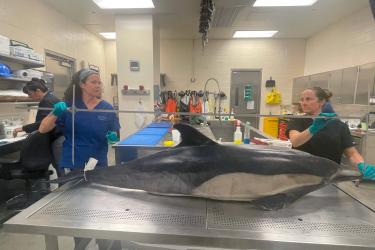When NOAA Fisheries Senior Scientist Jay Barlow wanted a low-cost way to assess whale populations off Southern California, he invented one. He devised a network of floating buoys that listens for whales. The buoys then triangulate and translate the acoustic data into information about the size, area, and trends in whale populations. Innovative and resourceful, Barlow is now a finalist for the Samuel J. Heyman Service to America Medals, also known as the "Sammies."
The Sammies are awarded by the Partnership for Public Service, and they represent one of the most prestigious forms of recognition for government employees. Barlow’s selection as a finalist recognizes the great value his service and science has provided for marine mammals and the American public.
"This award recognizes his world-class science and its application to management as well as the development of cutting-edge technologies that collect more data at lower cost to the public in logistically challenging environments," said Kristen Koch, director of NOAA Fisheries' Southwest Fisheries Science Center.
Barlow’s work primarily focuses on assessing and monitoring marine mammals and ensuring their well-being, in part by examining the negative impacts of some human activities.
Reduce Impacts on Marine Life
Barlow has worked with the U.S. Navy to estimate the number of marine mammals that could be affected by at-sea training and ordnance testing. He also has worked with the Bureau of Ocean Energy Management to plan new construction of energy resources in a way that will least affect surrounding marine life.
"Jay has saved the lives of tens of thousands of marine mammals by being innovative, creative and collaborative," said Jeff Moore, leader of the California Current Marine Mammal Assessment program at the Center. "He has done his job as a scientist to help follow the Marine Mammal Protection Act by regulating and maintaining populations at a healthy level, but at the same time allowing fisheries and fishermen to continue with their livelihood."
Acoustic technology such as the drifting buoys can help measure the size of a marine mammal population. They can also identify new species by recording their unique sounds, which scientists can match to a species of whale. Barlow helped lead a team of scientists that late last year captured photographs, video, and sounds of what is possibly a new beaked whale species north of Mexico’s San Benito Islands.
Barlow described the discovery as "sending chills up my spine."
Thanks to similar acoustic data, Barlow will soon publish the first estimate of the number of beaked whales in a one million square-kilometer survey area stretching from the Mexican to the Canadian border.
"Jay has been very devoted to making sure that we approach conservation issues with the best possible science and quantitative information we have," said Andrew J. Read, director of the Duke University Marine Laboratory. "He brought a level of quantitative rigor to our entire field and set a standard for how things should be done."
Crucial New Technology
Marine mammal research continues to grow in importance, said Lisa Ballance, director of the Marine Mammal Institute at Oregon State University. That makes Barlow’s expertise and the new technology he has developed all the more crucial.
"In the last decade or two, we have increasingly seen that the oceans are impacted by a wide variety of human activities like fishing, oil and gas exploration, and defense," Ballance said. "So the big challenge is using the ocean in a sustainable way so that all the parts remain healthy, and therefore all of the various entities that need the ocean can continue to thrive."
Barlow also was instrumental in placing "pingers" on fishing nets in California in the 1990s. These are small devices on massive nets that make noise and cause marine mammals to swim away, thereby not becoming part of the net bycatch. The pingers led to lasting reductions in whale and dolphin deaths off the coast of California two decades ago.
Barlow said it is a "fundamental government role to protect marine mammals" while balancing that requirement with the needs of the fishing industry and other economic activities.
"I have the best job in the world," Barlow said. "It lets me go out to sea for a month or two every year. It allows me to design, test, and share new technologies. And it has allowed me to solve real world problems."
Barlow is also credited with innovative changes to the Marine Mammal Protection Act in 1994. These changes literally re-wrote the law by which marine mammals are managed in the United States. He and three of his NOAA collaborators won a Department of Commerce Gold Medal for that work.
All finalists are eligible for the Service to America Medals People’s Choice Award. Beginning Sunday, May 2, at 6 pm EDT, members of the public can vote online for the federal employee they believe has made the most significant contributions in public service. The People’s Choice winner will be announced in the summer.


